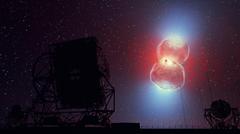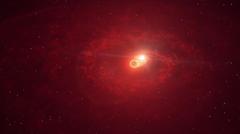URL: https://www.desy.de/news/news_search/index_eng.html
Breadcrumb Navigation
DESY News: Cosmic particle accelerator at its limit
News
News from the DESY research centre
Cosmic particle accelerator at its limit
With the help of special telescopes, researchers have observed a cosmic particle accelerator as never before. Observations made with the gamma ray observatory H.E.S.S. in Namibia show for the first time the course of an acceleration process in a stellar process called a nova, which comprises powerful eruptions on the surface of a white dwarf. A nova creates a shock wave that tears through the surrounding medium, pulling particles with it and accelerating them to extreme energies. Surprisingly, the nova “RS Ophiuchi” seems to cause particles to accelerate at speeds reaching the theoretical limit, corresponding to ideal conditions. The research has been published in the journal Science.

Artist’s impression of the RS Ophiuchi Nova outburst. The fast shockwaves form an hourglass shape as they expand, in which gamma rays are produced. This gamma-ray emission is then detected by the H.E.S.S. telescopes (shown in the foreground). Image: DESY/H.E.S.S., Science Communication Lab
The research group observed that the particles were accelerated to energies several hundreds of times higher than previously observed in novae. Additionally, the energy released as a result of the explosion was transformed extremely efficiently into accelerated protons and heavy nuclei, such that the particle acceleration reached the maximum speeds calculated in theoretical models. According to Ruslan Konno, one of the lead authors of the study and a doctoral candidate at DESY in Zeuthen, “The observation that the theoretical limit for particle acceleration can actually be reached in genuine cosmic shock waves has enormous implications for astrophysics. It suggests that the acceleration process could be just as efficient in their much more extreme relatives, supernovae.”

Artist's impression of the white dwarf and red giant binary system following the nova outburst. Material ejected from the surface of the white dwarf generates shockwaves that rapidly expand, forming an hourglass shape. Particles are accelerated at these shock fronts, which collide with the dense wind of the red giant star to produce very-high-energy gamma-ray photons. Image: DESY/H.E.S.S., Science Communication Lab
Specific telescopes were required for these measurements. The H.E.S.S. facility (which stands for High Energy Stereoscopic System) in Namibia consists of five Cherenkov telescopes that are used to investigate gamma rays from space. A new, highly sensitive state-of-the-art camera – known as FlashCam – was recently installed in the largest telescope. The FlashCam design is currently being further developed for the next generation gamma-ray observatory, the Cherenkov Telescope Array (CTA). “The new camera has been in use since late 2019, and this measurement shows just how much potential the latest generation of cameras has,” explains Simon Steinmaßl, a doctoral candidate at the Max Planck Institute for Nuclear Physics in Heidelberg, who was involved in analysing the camera data.
The telescopes were pointed towards the nova at very short notice after amateur astronomers first reported the nova to the astrophysics community. The success of the observation was due in no small part to the rapid reaction of the researchers and the wider astronomical community, paving the way for extensive subsequent observations. H.E.S.S. Director Stefan Wagner, a professor at the regional observatory in Heidelberg, explains, “Over the next few years, research using the CTA telescopes will show whether this type of nova is special.” In addition, researchers now have a clearer idea of what to look for. This gives rise to a number of new possibilities for gaining a better understanding and being better able to explain events linked to novae. “This measurement is a further success in gamma-ray astronomy and an encouraging sign that we will be able to study many more cosmic explosions with H.E.S.S. and gamma-ray telescopes of the future.”

Artist’s impression of the RS Ophiuchi binary star system, which is comprised of a white dwarf (background) and red giant that orbit each other. Material from the red giant is continually accreted by the companion star. Image: DESY/H.E.S.S., Science Communication Lab
The High Energy Stereoscopy System (H.E.S.S.) is an array of five imaging atmospheric Cherenkov telescopes for studying cosmic gamma rays. The observatory is operated through an international collaboration. The telescopes are located in Namibia, near the Gamsberg mountain, in a region known for its excellent optical properties. Four H.E.S.S. telescopes went into operation in 2002/2003, the much larger fifth telescope known as H.E.S.S. II is operational since July 2012 and extends the energy coverage towards lower energies, as well as further improving sensitivity. More than 230 researchers from 41 institutes in 15 different countries are involved in H.E.S.S.
Reference
Detection of TeV gamma-ray emission from the recurrent nova RS Oph in its 2021 outburst; The H.E.S.S. collabroation; Science, 2022; DOI: 10.1126/science.abn0567



